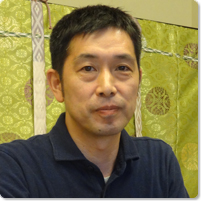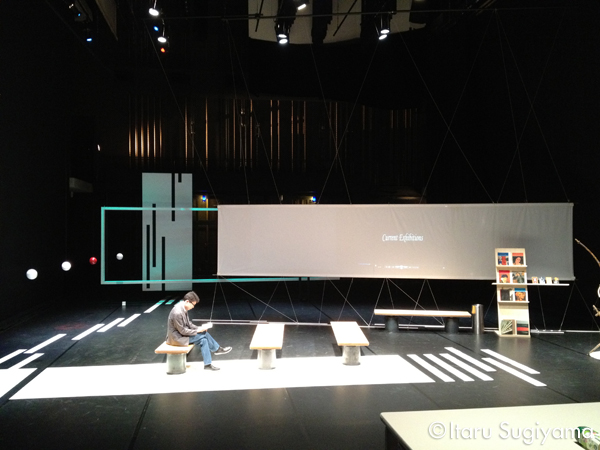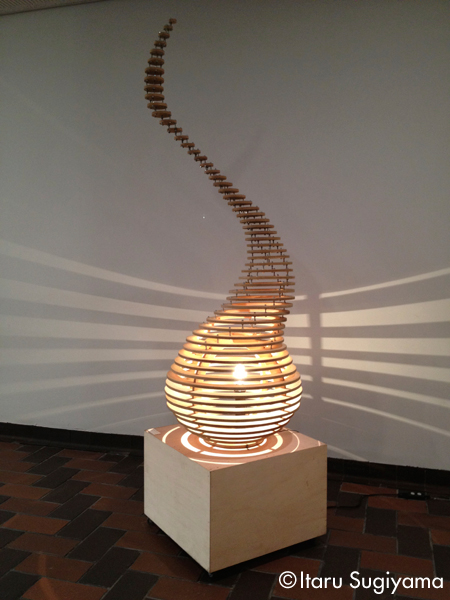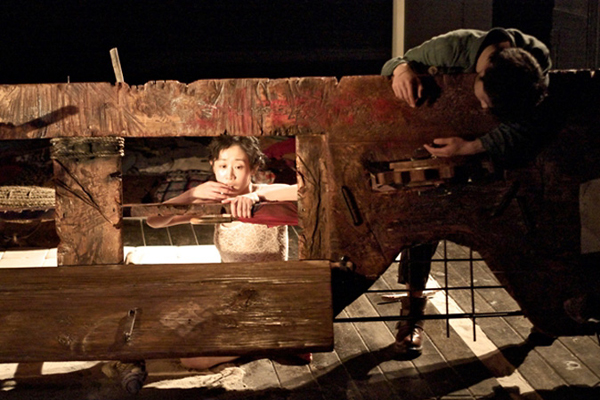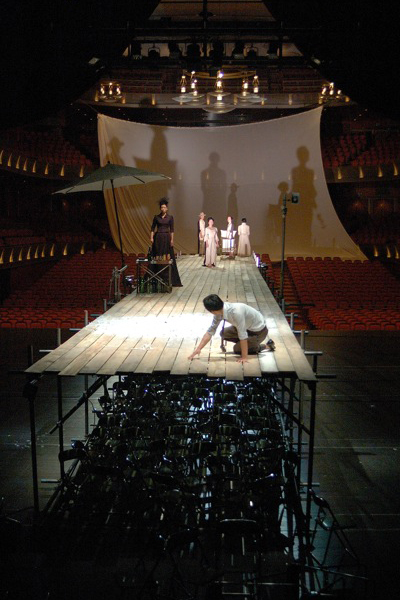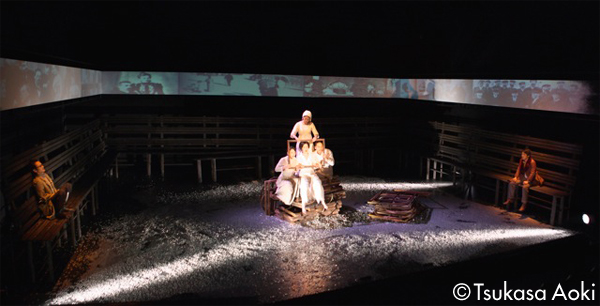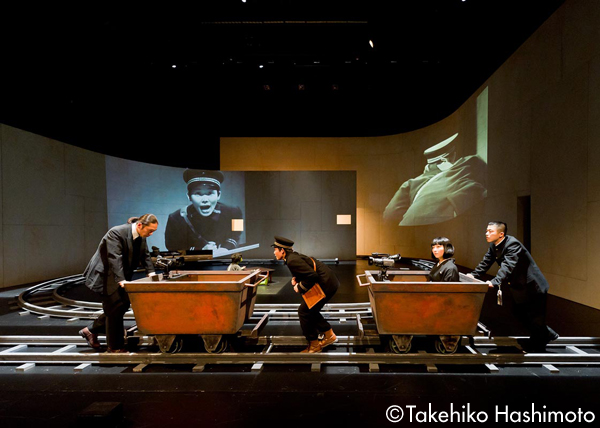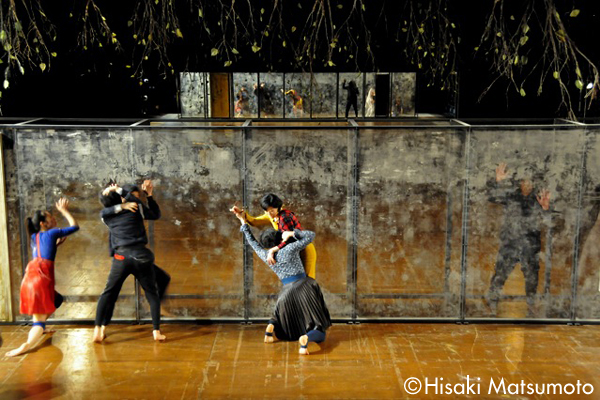The road to becoming a stage art creator
- You studied at the International Christian University (ICU) in Tokyo and it was there at university that you met your colleague in theater, Oriza Hirata. Did your interest in theater and stage art precede that encounter?
- Before starting university, I had never imagined that I would be entering the world of theater. My high school didn’t have a theater club and I was playing guitar of bass in a circle of band members that played heavy metal or hard rock. What you might call my first encounter with theater was seeing the play that my underclassmen at high school performed, and although it wasn’t much of a play, it was still quite a culture shock for me.
- Was there any influence in the area of theater from members of your family?
- Absolutely none. My father, Yoshimu Sugiyama, was well known as a scholar of German and for his research concerning Bach’s religious music. So I grew up in a home where Bach’s music was as familiar as lullabies, and I had come to listen to classical music naturally, but I had no connection with theater through my home environment whatsoever. I happened to live in what you would call a “bed town” in Kawasaki and most of the people living there were middle-class families living in that suburban environment cut off from their regional or local roots. It was a place where people were sensitive to thing that were new, but as a town it had no traditional culture.
- Do you feel that growing up in that kind of environment had any significant influence on yourself today?
- I was very much influenced by it. I had a very strong complex with regard to my father’s academic success, and that is why I chose a completely different path for myself. Recovering from that [complex] turned out to be quite difficult.
- Were there any original experiences that led you toward stage art?
- There was one. In high school there was a competition between classes to create original mascots for our school sports festival. I served and the lead builder for our class and our mascot won the competition. Looking back now, I think it was actually quite a good creation. The body was formed of bamboo, around which paper was pasted to make an “Eagle Sam” that had become popular at the time as the mascot of the Los Angeles Olympics. What was great about our design was the head moved and its was made so that we could make the eyes wink, the hat move and the arms raise. I had never seen a mascot that could perform so many movements! (Laughs) Thinking about it now, I realize was the first time I really got hooked on the same process of drawing plans and following them with a group of fellow workers to create stage art, like I do today.
I had always like creating things in school art projects. I especially like the process of thinking about how to build the structure for something, and when I was in elementary school I remember how I liked taking apart things like bicycles and refrigerators and then putting them back together again. - Did you never think about going to an art college?
- For some reason I didn’t. If I had learned about architecture in junior high school or high school, I think I definitely chosen to go in that direction. In high school I had liked physics, and when studying for university I tended in that direction at first. But, at the same time I was becoming interested in philosophy and literature, and I was thinking for some time that I wanted to work toward a fusion of philosophy and physics. Finally, after studying a variety of things at college I realized that in fact architecture was the field where that fusion would be possible. So, it took me a long time to come full circle to that conclusion.
- What was your encounter with Oriza [Hirata] like?
- Oriza-san is four years older than me, and the first time I met him was at a presentation by the theater circle for new students entering the university as freshmen. At the time, the Seinendan theater company was very different from what it is now, and they were doing things like the plays of Hideki Noda. The talk that Oriza gave was very interesting, and it made me feel that he was an amazing person, a person with real vision. He seemed to have a yellowish aura or halo around him! (Laughs) Oriza-san went to study for a while at Yonsei University in South Korea, and when he came back and graduated from university, he was active at Seinendan theater company and at the same time working as manager of the Komaba Agora Theater.
So, I joined Seinendan and took up residence in a shared boarding house named Penguin Village that Oriza-san had set up by renting an 80-year-old farm house in Mitaka, Tokyo. There I lived communally with underclassmen from the cycling club, the Wandervogel outdoor club, and the theater clubs that Oriza had been involved in. It was a house where there were not only theater people but people with a variety of interests, and every night people would gather and talk about philosophy and such. It was a very interesting place to be and I stayed there for about two years.
From that time, I realized that Oriza was very skillful at creating “places.” I too have an interest is creating places where people from different genres can meet and interact, and that may be one of his influences on me. In my third year at university, at a time when I was completely absorbed in theater, Oriza-san told me, “You have to go abroad while you are still young.” So, I went on a journey, traveling in China for a month and a half, in Nepal for another month and a half and then Europe for a month. - What made you decide to specialize in stage art?
- A big part of it was meeting my senior at Seinendan, Roka Kito, who was in charge of most of the set and lighting designs in the early years. He is the son of Azusa Kito, an architect of the same generation as Kenzo Tange who is known as the foremost designer of libraries in Japan. At the time, for all of the members of Seinendan, working as staff for either the building of the stage sets, making of costumes or props was part of our job as members of the company. I was one who like the work of making things, so, along with my work as an actor, I was helping Roka-san with the building of the stage art from my first year with the company. He would asked me, “Do you know Frank Lloyd Wright? Do you know Louis Kahn?” And, as he taught me about the different architects and their works, I became interested in architecture as well.
After I returned from my travels in Europe and then went to Korea for overseas performances of Seoul Shimin (Citizens of Seoul) for the first time, when we had moved the production into the theater and beginning our rehearsals, I found myself worrying more about the parts of the set that still weren’t finished than my role as an actor, so I couldn’t concentrate properly on my acting. That’s when I realized that I wanted to do stage art more than acting.
Another thing that had happened to me was my encounter with the architecture of Gaudi in Barcelona while I was traveling in Europe. The city itself is amazing and the architecture of Gaudi had a special light all its own. I also saw works by Picasso and Miro and the whole experience nearly threw me into a panic. At our university there was a professor who taught a very interesting physical education class called Karada Saiko (Rethinking the Body) and that professor said, “The body is twisted. And because it is twisted it is capable of very pliant and gentle movements.” When I saw Gaudi’s buildings, I felt a connection to those words. It was truly inspiring for me to see his buildings that, while solidly based in the laws of gravity, had beautiful wave-like curves and twisted lines in the overall structures of the buildings that were nonetheless logical in their derivation. Seeing this, I realized that Gaudi had a pragmatism based on observation of nature and that he was one who had truly achieved an integration on physics and thought. With this revelation in my mind, I spent about three years from the age of 27 where I was working for a company that provided theaters with stage staff while also continuing my activities with Seinendan and then going to night courses at Waseda University to study architecture. - So, those three years were a period of training from which the stage artist Itaru Sugiyama would emerge?
- Yes, I guess it was. When I was first at Seinendan, I was just Roka-san’s assistant, but after he moved to America, he would send plans (blueprints) for the stage art to us by FAX, and eventually I got to the point where I was drawing the plans myself. For example, Roka-san did the initial plans for Minami e, for From S Plateau and Tokyo Notes, but I did the plans for Northernmost Monkeys and Kataku ka Shura ka? (A Burning House, or Shambles?). By the way, the stage staff company I worked at was also an interesting place where they though about things like what a stage director could do for work around town, and thanks to that I was able to get work designing sets for a variety of events.
A stage art designer isn’t a profession that has any license or certification to practice, so I can’t say from what point I became a stage art designer, but as long as I am working in this profession, I felt that I needed to be informed about stage art in Japan, so from around the year 2000 I started a study group on the subject that met at the rehearsal studio of the Agora Theater. However, about the only reference material I could find was the book Butai Bijutsu no Kenkyu (Research on Stage Art) published in 1941. There have been no studies published since then, and since I was in a position where I had to lecture on the subject at the university level, I got everyone in our study group to gather material on the subject to study.
An approach to scenography that designs spaces based on “physical knowledge”
- In the year 2000, a theater major was established in the literary arts department of Tokyo’s Obirin University and you became a lecturer on the subject of stage art/design.
- At university they talk about, “What is performing arts,” and then they talk about, “what is scenography.” In Japanese, performing arts is translated as butai geijutsu (stage arts), but performing is not something that is limited to the stage. In the same way, scenography is translated as butai bijutsu (meaning stage design or stage art). But, since the roots of the word are “scene” and “graphics” it doesn’t limit it to the stage, but only means creating a scene, depicting a set of conditions or a place. That is why I call the work I do scenography, and the work that I am interested in is creating an overall design that will define the conditions or place that the audience finds when they enter. In other words, I am interested in designing total spaces.
When you study the subject, the origins of modern stage art lies in stage designers who emerged around the Renaissance and Baroque periods, but they didn’t call themselves architects or artists. But, they were indeed doing what can be seen as total space design. I realized that that is exactly what I wanted to do. Today, a lot of division of labor has permeated the field but what attracts me most is the kind of original theater-making process where people all work together across lines of specialty to create a production, and I feel the same kind of attraction to the word scenography. - So, does that mean that, rather than in a proscenium type theater where there is a clear division between the stage and the audience space, you prefer freer types of spaces like those on the small-theater scene or warehouses and the like?
- During my university years, I really loved working in places like conference rooms and designing spaces freely using pipe scaffolding and such. I still feel the same way today, and having come from those origins, I like spaces where there is more freedom to design them at will.
It is said that the outdoor amphitheaters of ancient Greece were designed originally based on the way people gather. In other words, they were built in the round because that made it easier for people to gather in them. Also, they were built with audience seating the fanned out to 220 degrees, which is the same field of peripheral vision that an actor on the stage would have, allowing them to perceive the state of the whole audience without having to turn their head. So, the Greek amphitheaters were theaters designed based on those kinds of life-based (biological) principles, or “physical knowledge” (embodied knowledge), but in the Roman (Empire) period, they cut the audience-seating ring down to a straight 180 degrees.
To me, the ancient Greek “physical knowledge” basis rings truer with my sensitivities. So, when I do stage art workshops, I take this as a key concept and I have the participants do things like trying to sharpen a pencil in complete darkness. Normally, of course, you think of sharpening a pencil as something you do while watching the process with your eyes, but actually it can be done in the dark when you can’t see. While doing it in the dark, I have the participants experience what senses they are relying on sharpen the pencil? There is the sound, the feeling of the hand, the smell, and some people even lick it to verify the progress. Although you may not be able to sharpen it as well as you might want, you realize that you are using several different sensory organs besides your eyes when sharpening a pencil. It may be the brain that brings together the input from the five senses, but I believe that it is possible for the brain to function that way because it is also part of the physical body. - In other words, you believe that this “physical knowledge” is an extremely important sensitivity in scenography design?
- Yes. When I was studying abroad on a Agency for Cultural Affairs grant, I visited a lot of different theaters, and I found that when you stand in an ancient Greek outdoor amphitheater you find the environment is wonderful, you will see things like the sea in the distance and the horizon. You can clearly see that the amphitheaters were designed with careful calculation for things like where the natural fragrances come from and where the wind and the sunlight come from. It made me feel that, in the same way, it would be interesting in scenography if you could get ideas by feeling spaces with all the five senses.
- Would you tell us specifically about some of the scenography you did for Oriza Hirata’s plays?
- For example, for Tokyo Notes the set had four benches, each of which had three sitting spots. Oriza-san had given me a kind of numerical formula, saying that he wanted a space where the relative seating positions of the actors on those benches would determine different variations of conversation or dialogue that he had written into the play. So, I set a clear set of axes X, Y and Z, and then created the space around that, including the audience space. However, if I tried to create spaces that way for a Sample (Shu Matsui), it would probably turn out to be a failure. It is because Oriza-san’s plays have that kind of structure to begin with, but with Matsui’s plays, even if they have that kind of structure initially, part way through the structure usually breaks down or begins to take unexpected twists, so that style of creating spaces doesn’t work. They are completely different, and that is what makes [scenography] so interesting.
- Because Oriza’s works have an aspect that is built around structured depictions of certain scenes from daily life, I can understand well how they lends themselves well to that king of design approach. You have also worked with Motoi Miura’s company Chiten, for which you have made very artistic spatial designs. For example, for the stage of The Cherry Orchard (2007) you covered a whole surface of the floor with one yen coins and you projected on the wall thin strips of video images of the Russian landscape flowing, creating an image of the landscape scene through the windows of a train, and you used that to create a symbolic image of a house with only its window frames in tatters. In another example, you completely reversed the positions of the stage and the audience seating and built a 30-meter long platform sticking out from the stage like a pier into the audience seating area and covered it with white bird feathers for the Chiten production of Chekov’s The Seagull (2007); and for Kappa/Aru Shosetsu (2011) you laid railway tracks on the stage and made the set a moving trolley. Then, for Chiten’s production of Chekov’s Three Sisters (2015) you designed a set with a heavy, giant glass wall that was pushed. With these and others, you have created a rich variety of stage spaces.
- I began working with Chiten from their production Knifes in Hens in 2005. Miura was a member of the directing department of Seinendan, and he began activities with Chiten in Seinendan’s independent performance program for young directors. At the time, younger theater companies didn’t have their own studios for pre-performance work, but in 2003, Oriza-san opened the Atelier Shunpusha studio and made it available as a studio space for young companies to use. As a result, Chiten was in the very fortunate position where they could rehearse at Shunpusha for two or three weeks and then go right into two or three weeks of performances at the same space. Knives in Hens is a very interesting play by Scottish playwright David Harrower. However, it is not a play that you can create a stage space for using the Naturalism approach, and when I realized that it requires some new kind of invention, the decision to make some kind of artistic object (Objet) that consisted of a variety of elements in collage and could serve as a stage set, I think that was a revolutionary turning point in my career.
It was in essence a large table, but it also had a mechanical aspect and could also take on the appearance of a horse. It could be used at times to represent a plain and it could also be used to represent the heavens and also the underground (or a basement). It could also become a door, or a room. It had the potential to be used for all kinds of things. Nonetheless, it also had a strong individuality and sense of material. And, Miura was able to use it very effectively and fully in his staging of the play. The subject of my graduation thesis at university was Kafka, and I feel Kafka’s writing has the great appeal that the more you try to explain it, the more you become enveloped in its mysteries. For example, in In the Penal Colony, there is a part that begins an explanation saying, “This mechanism is …,” but the longer the explanation gets and the more words that are use, the more confused you become about what the thing being described actually is. In the same way, I wanted to try making something that can be seen and seems to be functioning in some way, but all you can call it is “that thing.” - What kind of exchange was there between you and Miura-san during the creative process?
- When working with Miura, it is not a process of one person coming up with a plan and just submitting it. Instead, plans are made through meetings with the entire staff, in a sort of workshop atmosphere with everyone working together. While experimenting with a variety of things, new ideas are added one after another. That method was interesting and fun, and when I worked with Sample, there would be not only the directors but also the dramaturge, lighting and sound people all their together in a clamorous atmosphere contributing to the process of developing the plans. When a production is made in this kind of workshop atmosphere, by the time the audience sees it, it is hard to tell what part was designed by the lighting designer, what was designed by the stage art creator, because it becomes a harmonious whole that is really fascinating.
- The year before last, you were awarded the best staff award of the Yomiuri Theater Grand Prix for your stage art for Tegami-za’s production Sora no Harmonica (The Sky’s Harmonica) and the Fukin Kobo (Windy Harp) production Kokugo no Jikan (Japanese Language Class).
- Tegami-za’s Ikue Osada is a writer who writes plays in a proper dramatic style and her play The Sky’s Harmonica takes as its subject the poet Misuzu Kaneko. Misuzu’s poems at first glance appear to be pretty poems for children, but they are actually a product of the poet’s cool-headed observation of the world like a scientist, and they search for beauty within things that are dirty and search for cruel realities within things that look beautiful at first. Osada-san wanted to show the world of Misuzu as one who would find “a beautiful patch of blue sky reflected in a dirty puddle on a back street.” So I designed the stage art with the idea that “here is a person who lives in a world where the sky and earth are inverted, so let’s turn things upside-down.” Roba Shimori-san of Windy Harp is similar to Oriza-san in that she is a type who will swing at any ball that is pitched to her, so she gave me quite a bit of freedom to design the set as I wanted.
- What about your collaborations with dancers and choreographers?
- I had the opportunity to take part in a project of the Kyoto University of Art and Design that was planned by Setsuko Yamada (dancer, choreographer), who was teaching there at the time. It was a program (2006 – 08) that involved studying the work of Jean Genet (French writer, poet, playwright) along with the translator Kuniichi Uno and others and then creating a [dance] work based on the research results. It was a program that I ended up learning a lot from. Although the end product would be a dance work, the initial point of departure was from words (literature), and once words were worked to the fullest, and [plastic] art worked to the fullest, and video used, it would then be reduced to point zero again and reconstructed, all in a free-form ongoing process. It was at that time that I met and worked with the dance artist Tsuyoshi Shirai.
After that, I worked on the stage art for Shirai’s work Seibutsuga – still life (2009), and I found him to be an intellectual person who approached things from the perspective of physics. For that work, the essay “The Atelier of Alberto Giacometti” by Genet, who had a special relationship with the sculptor Giacometti, played a particularly important role. Aided also by analysis of a book written by the philosopher Isaku Yanaihara, who was a friend of Giacometti, I took the title of a Giacometti still life “Representing things you can see as you see them” as key words and worked from a quite conceptual approach.
In specific terms, I was wondering if I could create a set with which “the more you worked things into it the more they disappeared.” I thought what it would be like if I could build things into the [stage] space and then have the things I built in become absorbed into the space and quickly turn into just natural (undistinguishable) parts of it. - You were involved in the early [stage] art design for Tennis no Ojisama (Prince of Tennis, commonly known as Tenimyu), the musical that pioneered the new genre of musical known as “2.5-dimensional musicals” that are based on manga comics or anime films and are appearing in increasing numbers recently; and you have also worked on stage art for operas. You are covering a wide range of genres and working with a variety of artists, and rather than working in a consistent style, you seem to vary your style at will.
- I often think of stage art as something like a drum. A drum is something that resonates when it is struck. If it isn’t struck it makes no sound, and the sound it makes will be completely different depending on the person that strikes it. Therefore, as a drum, I train myself so that, no matter who strikes on me, it will be OK. And, I find it tremendously enjoyable the way, depending on the person that strikes on me, entirely new ideas that I would never have thought of normally just pop right out.
In opera, we will be doing Oriza-san’s new work Umi, Shizukana Umi (Sea, Quiet Sea; composer: Toshio Hosokawa; conductor: Kent Nagano) in January 2016 at the Hamburg State Opera House. The plans are complete and the blueprints were sent to Hamburg. In Germany they have a system called bauprobe that involves submitting tentative plans for the stage art about one year in advance so that they can be reviewed by the director and lighting designer as blueprints or as a model and then make requests or suggestions for revisions. In Japan it is expected that the set will be completed according to the specifications of the blueprints by the time the production moves into the theater, so this process is not necessary, and it isn’t needed because neither Oriza-san nor myself have any comments we want to make (laughs).
Doing the stage art for the 2.5-dimensional musical productions was very difficult for me. In order to take the 2-dimensional illustrations of manga or anime and translate them into 3-dimensional spaces, I had to invent something new. I think it is a matter of exploiting the high-level Japan’s projection mapping technology and finding how it can be put to use in stage art, but it is not an easy task. Lately, video artists have found that rater than projecting on flat surfaces, they want to develop their works in 3-dimensional ways. So, I think it will be very interesting if artists and video creators can work together to create things like stage art.
Borrowing the concept of the “2000 problem” (Y2K issue) of the computer world, they are now calling this the “stage art 2000 problem”, and since it was just about the year 2000 that projection began to be used in stage art, that was when the need began to arise for the 2-dimensional art to project on stage sets. I believe this may be a revolutionary turning point for stage art.
Tracing back through history, it was with the invention of the theory of vanishing-point perspective in 15th-century Europe that people began the pursuit of finding ways to create the “depth illusion” that gives sets in a proscenium stage the look of depth perception that then continued into the 20th century. Trick art, or trompe-l’oei, has long been used to create optical illusions [of 3-dimensionality] in stage art. In stage art today, this has been replaced by the use of white [flat] surfaces to project images on. This might be considered one of the biggest turning points in stage art in the past 500 years. From now on, stage art creators may have to seriously rethink the way they work and live.
Rokushakudo, a joint workshop for stage art creators and directors
- You serve as the director of the stage art study workshop Rokushakudo in Tokyo’s Gotanda district, which is jointly run by stage art creators and stage directors. Many creators from the Tokyo small-theater world participate in it in a situation that is like a joint workshop for small theaters.
- I like the kind of activities where many people gather and interact noisily as they work. A workplace where everyone can be their own boss and everyone can be an artist in their own right. In other words, I want to make a place that can be a gathering of the bold and ambitious. No one can have a that kind of place working alone, so I gathered friends and suggested that we all do it together, and at first we formed a group named Tokkan-ya, and then we formed Rokushakudo as its successor. Though it may be called a joint workshop, there is no one who is there to formally teach others and no one is trying to raise apprentices to eventually promote in the industry; what I wanted to make is a place where people could come and learn what they want and try experimental things as they wished.
Lately, we are seeing the emergence of a number of shared studios, but there is a lack of studios that people can use as their own atelier. Rokushakudo is equipped with stage equipment and a workshop where people can make things like costumes, props and sets. I often have the opportunity to go to theaters in France with Oriza-san, and over there it is normal for each theater to have a workshop for those purposes. I would like to see public theaters [in Japan] have facilities that would allow companies to move in for a month and have a studio where they can rehearse and a place where they can gradually build their set ad props and move them into the atelier piece by piece. If public halls had those kinds of facilities, it would be possible for them to train the next generation of young theater people. Particularly when you are young, it is best if you can make plans and then build the stage art with your own hands. It is only if you have that the experience of building sets yourself with a do-it-yourself spirit that you can learn firsthand about how the structures are built. In short, stage art is another form of “physical knowledge.”
Recently, we invited to Japan the Dutch stage artist Peter de Kimpe, who a Rokushakudo member had gotten to know while studying abroad in the Netherlands on a Agency for Cultural Affairs grant. He is an interesting creator who also does landscape design and brings a broad perspective to stage design. After showing him around Rokushakudo, he said, “It’s like what we were doing back in the 1970s. We were making communities like this.” It was very moving for me to hear about how at the time in the seventies they were gathering all kinds of people together and working in a vivacious atmosphere like social activists. Of course, that means that, in terms of era, what we are doing now is actually a form of retrogression (laughs). - How many members do you have in Roukshakudo now?
- There are 14 or 15 stage art creators, seven or eight stage directors and one set constructor, which brings the total to 20. In the past, the profession of the stage art designer was something learned in a master-apprentice working relationship, but what I want to make is not that kind of environment but one where people can come and learn what they want and people seeking knowledge can come and find information, and an environment where there will always be encounters with a variety of interesting people.
- Oriza Hirata is one who has done a lot of things to nurture young talent, such as starting the Seinendan Link program at that enabled talented young directors to stage and perform their own productions, making the Atelier Shunpusha available to companies and providing study opportunities at the “Murinkan” theater school for free. He also serves on the board of directors of Rokushakudo, doesn’t he?
- Oriza-san is truly a man who works hard to till the land [so it yield a rich crop of new talent]. What makes Seinendan Link and Murinkan such good programs is that no one tries to imitate Oriza Hirata’s works. He has always said that trying to be like Oriza Hirata is a meaningless pursuit, so all of the people participating in these programs have taken the things that Oriza-san has done as a launch platform from which to pursue their own path as artists. Companies like faifai, Sample, Tokyo Deathlock and Mamagoto are all good examples; and what they all have in common is that they are not just concerned with the Tokyo theater scene but are actively enjoying working with communities throughout Japan or abroad. Having all been through Seinendan, they know how to enjoy and love the work they do. I have the greatest respect for the way Oriza-san nurtures theater people.
- Recently, the Rokushakudo members have also been involved in designing theaters, haven’t they?
- The first case of this was the improvements made on Atelier Shunpusha, and there are a number of others, including a project that turned a convention facility into the Kinosaki International Art Center [artist] residence facility and a project that renovated an old rural home and turned it into the Kamigo Clove Theater that serves as a venue for the Echigo Tsumari Art Triennale.
I feel that the appeal of this kind of work is to “Do what we can” and to “Do it the way we can, and with the methods we have,” but I also feel that Japan today is going in the opposite direction. When I was in my third year at university I went to Nepal on a work camp project, and I believe it was then that I learned the importance of doing things the way you can. We were in a village way up in the mountains and we were there to install a pumping unit to pump water from the nearest water source to water supply facility in the village, but we had forgotten to buy the pipe-connecting spigot for the pump. When the villagers heard that, they made a connector out of bamboo. We said, “Is this good enough. If we get a proper pipe connector it will last 10 years.” But they said, “We don’t need it. This is our local technique. With this, we can fix it when it wears out.” It made me think that this is the kind of strength that is really necessary in life. I believe that this kind of local technique, this kind of essential culture for living is something Japan today is losing. - In Shinagawa where your Rokushakudo is located, I hear that you also participate in the local festivals and that you are working with the local chamber of commerce to create another new space.
- I have long been incubating an idea that I would like to create a cultural hub in the community. A place that would be not only a shared workshop, but also a place where people can gather and commune and talk about the special appeal our community has and the things we can do here.
- Listening to you speak with us today, it has become very clear to me that your interests go well beyond the field of theater and stage art, that you are interested in creating spaces truly in the broad sense of the root words of scenography, “scene” and “graphics” and that you consider stage art to be merely one aspect of this larger picture.
- Yes. That is why I don’t consider doing opera and doing theater to be different things at all, and doing things in the theater and doing them outdoors are on the same plane for me. Recently I heard something very stimulating from the art director Takashi Serizawa (P3 art and environment) when he said that contemporary artists today want to break out of the “white cube” of the museum. In my case, that is the equivalent of wanting to break out of the “black box” of the theater, and in fact, I also think that anyplace can become a theater, so I realized that I have been doing the same thing as contemporary artists.
Baroque artists were doing the same kind of thing long ago. For example, the Italian Gian Lorenzo Bernini is introduced in Wikipedia as a sculptor, architect and painter, and in fact, when he was young he also had experience doing a lot of stage art. In other words, I believe that he was doing all these things with a “scene” and “graphics” orientation. That is my ideal.
The way you get people to meet, the way you bring the art and the audience together, the way you create an encounter with the art work itself, what you do with the response of discourse and the space and the way you control the visual sense, these are all aspects of “scene” and “graphics.” Eventually, what I am interested in is the way people are connected and how the design of the space is involved in it. That is why I love places where live people are gathered there in the flesh.


